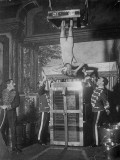Chinese Water Torture Cell
Designer: Harry Houdini
Houdini would gesture towards a glass tank being filled with water. As the tank filled, Houdini would leave the stage and return dressed in a bathing suit. He would then lie down and heavy stocks would be placed around his feet. He would then be hoisted into the air and dropped head-first into the water-filled tank. Water would gush over the sides of the tank and onto a tarp on the stage. A cover would then be locked on the tank and a cabinet placed around the entire cell. Houdini would wait 3 minutes as the orchestra played “The Diver” or “Asleep in the Deep.” After 3 minutes, he would emerge from behind the curtain breathing heavily.
Houdini designed the Torture Cell to be a death-defying escape challenge. The first cell was built in 1911 in England. It is said that Houdini first performed the effect for one person. He called this performance a one-act play entitled “Houdini Upside Down” so that he could enjoy a copyright for the new escape. Patents had proved limited in their abilities to prevent copycats (consider his milk can escape).
Houdini called his effect “The Upside Down” and it is often referred to as USD on the internet. During his 14 years performing the escape, he never was injured until Oct 11, 1926. On this date, Houdini was playing the Capitol Theater in Albany, New York. He was attended onstage by Dr. Elwynn Hannock (or Brannock). Just as he was being raised from the stage, one of the cables loosened and twisted, causing the heavy stocks (weighing over 100 lbs) to shift and fracture his ankle. The next day the papers made much of the doctor’s comment that had the cable loosened only three seconds later, Houdini’s foot would have been completely severed. Houdini himself quipped, “Into all kinds of danger I have thrown myself, and I have not been touched. Then I lie on my back and fracture my foot!” Nevertheless, doctors told him he should be well within a month, but unfortunately he passed away just 20 days later on Halloween. Several Hollywood movies depicted Houdini drowning in the torture cell, but this was mere sensationalism (Houdini actually died from a ruptured appendix likely due to permitting a young man to punch him in the stomach in his dressing room before he had adequate time to get set.).
After Houdini’s death, the cell was willed to his brother Theodore Hardeen. Hardeen never performed the cell himself, and despite Houdini’s instructions for it to be “burnt and destroyed” upon Hardeen’s death, his brother gave the cell to Houdini collector Sidney Hollis Radner in the 1940s. The cell remained in the Radner basement until 1971 when it was put on display at The Houdini Magical Hall of Fame in Niagara Falls, Canada. Here the cell suffered from neglect and theft. At one point, the museum owners put a fish tank inside the cell to achieve an aquarium effect. The leaky tank caused mold and damage to the cell wood and structure.
In 1995, the Houdini Magical Hall of Fame burned to the ground. It was initially reported that the cell was completely destroyed, but the metal frame survived and the cell was restored by illusion builder John Gaughan. In 2004, the restored cell was sold at auction to illusionist David Copperfield where it now resides as part of his massive private magic collection.
Sidney Radner gave the burned wood, screws, nails, metal straps and many other unused pieces of the original Water Torture Cell to Geno Munari. Geno Munari provided John Gaughan an original back-up Water Torture Cell glass plate from The Houdini Museum in Las Vegas. This backup glass traveled with Houdini as a spare in case the Water Torture Cell had to be axed to save Houdini’s life.
In 2003, an exact duplicate of the Water Torture Cell was discovered, leading to controversy over the authenticity of the restored cell. Sidney Radner filed suit against John Gaughan.
Information compiled from common public knowledge, multiple internet sources and published sources including Wikipedia, Genii forums, wildabouthoudini.com, thegreatharryhoudini.com, and Genii magazine Vol. 27, No. 2 – Oct. 1962.

